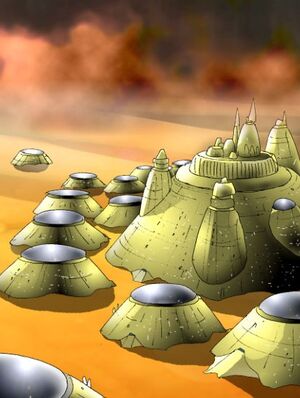Oasis Tower
Oasis towers are probably the most unique and distinctive of all desert dwellings and are found along caravan routes and at other strategic locations in the Badlands. They are huge enclosed towers made out of the local rock and sealed against the oppressive heat of the surrounding desert, protecting hundreds of people from the harsh environment outside. The lower half is buried in the sand to remain cool, and pumping stations placed in the lower levels ensure a sufficient water supply for everyone. Sensors, solar panels, moisture condensers and weapon ports dot the exposed surfaces. Originally built to shelter passing travelers, the towers are now both waystations and towns in their own right.
Construction and Ownership
Oasis towers — or simply oases — are massive stone shelters that line major caravan routes and cover many wells. The basic oasis structure (see diagram above) consists of a truncated cone made of local stone buried deep into the bedrock and emerging from the desert sand. A spiral passageway connects the outer doors to the interior, which is cooled to a comfortable 25 to 30°C by a massive ventilation system. A habitat tower stands at the oasis’ center, providing apartments, shops and other facilities. Repair and other industrial facilities are usually limited to the oasis' floor. Hanging gardens stretch from the tower to the oasis wall every five stories, providing food for the inhabitants and helping to filter the air.
Oasis systems are usually powered by massive solar panels on the structure’s roof that can also be set to reflect sunlight into the oasis interior to provide natural light that filters through the hanging gardens.
Obviously, only wealthy corporations and leagues can afford such a massive construction project. Oases were first built by polar mining concerns in the seventeenth century, but many of these became independent when the companies went bankrupt after the St. Vincent’s War. These “free oases” still dot the Eastern Desert.
Today, most oases are sponsored by Paxton Arms. The Badlands conglomerate oversees its oases, but grants the citizens a large degree of self rule, so long as they continue to offer shelter to travelers and remain independent of polar power. Polar corporations and leagues have also built some private oases at strategic locations, but these are often closed to travelers and so are not considered “true” oases.
Oasis Dwellers
Oases exist to provide shelter from the hostile climate of the Badlands and fully half their population consists of transients. These travelers stay anywhere from a day to a season before continuing on their way, paying a fee to remain longer than a day. Permanent residents pay taxes and are usually either employed as maintenance workers by the oasis sponsor or in independent businesses providing services to transients.
Most residents specialize in technical skills (vehicle repair, hydroponic farming, medical services) or in entertainment. Although oases are complete communities with schools and churches, those who wish to obtain a higher education must usually travel to the city-states .
Quarantine
Enclosed oasis towers are extremely vulnerable to contagion. Newcomers are quarantined and must submit to a medical exam before being granted a day pass. The waiting period is usually about an hour, but has been known to stretch to weeks during peak times.
Few people complain, however, remembering that in TN 1862 the Montcalm Oasis in the Eastern Desert was wiped out by a virulent fever when an impatient oasis official let in a large trade caravan without the proper medical exams. The oasis remains uninhabitable to this day.



